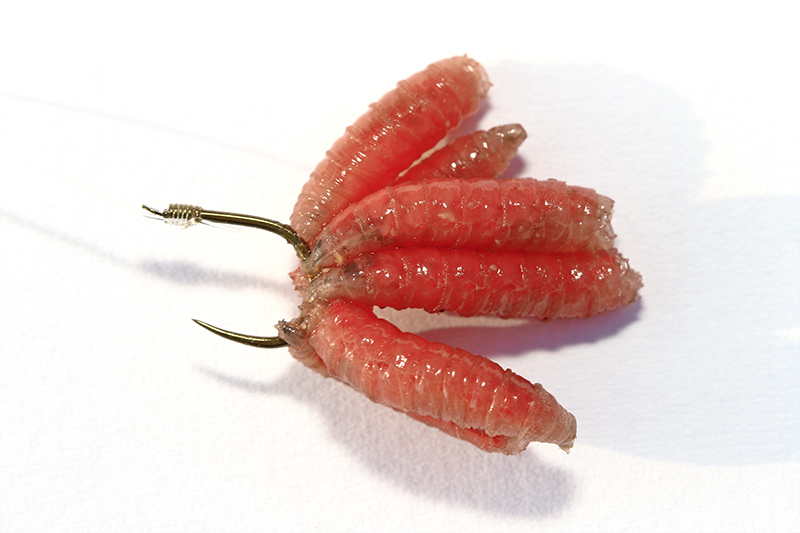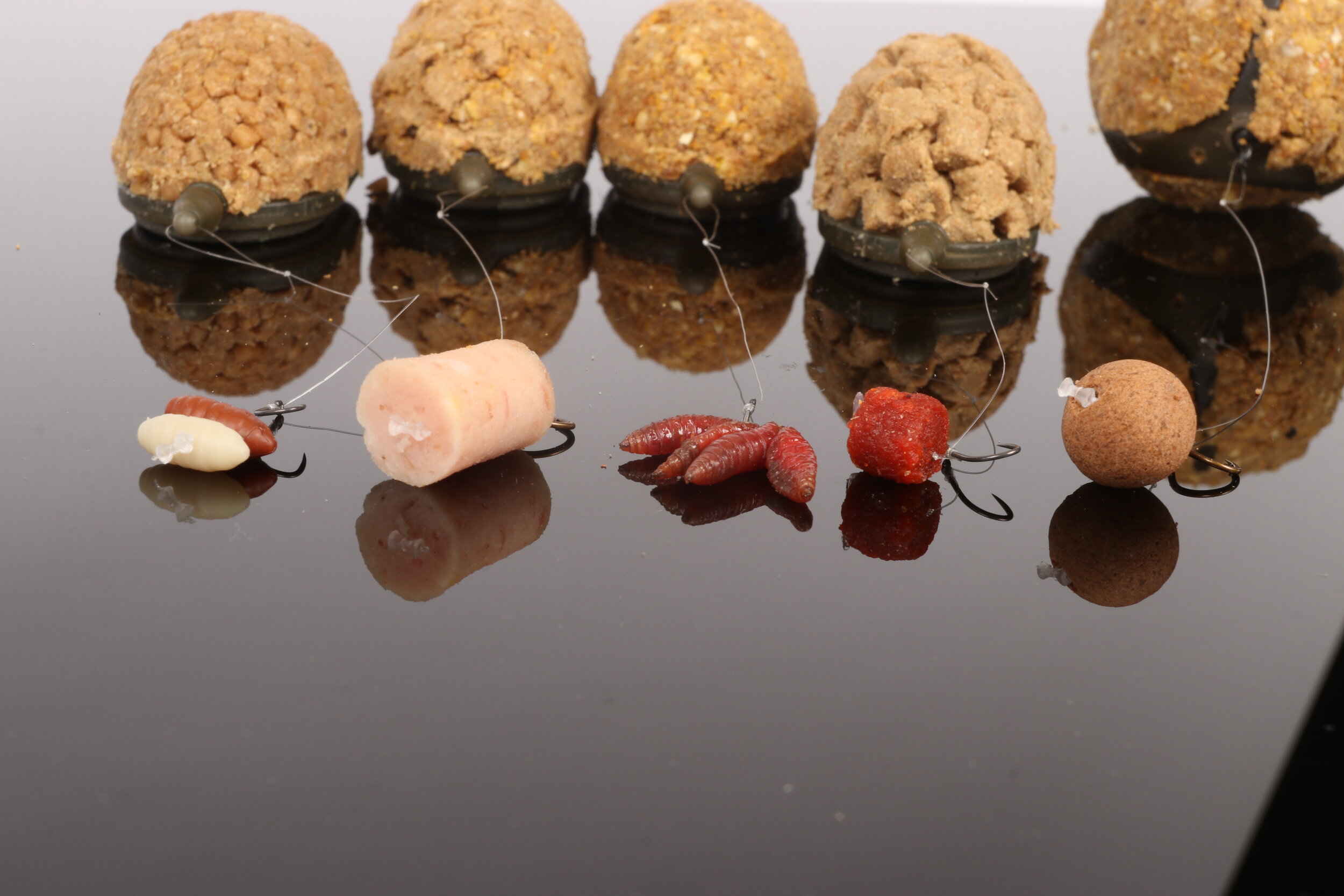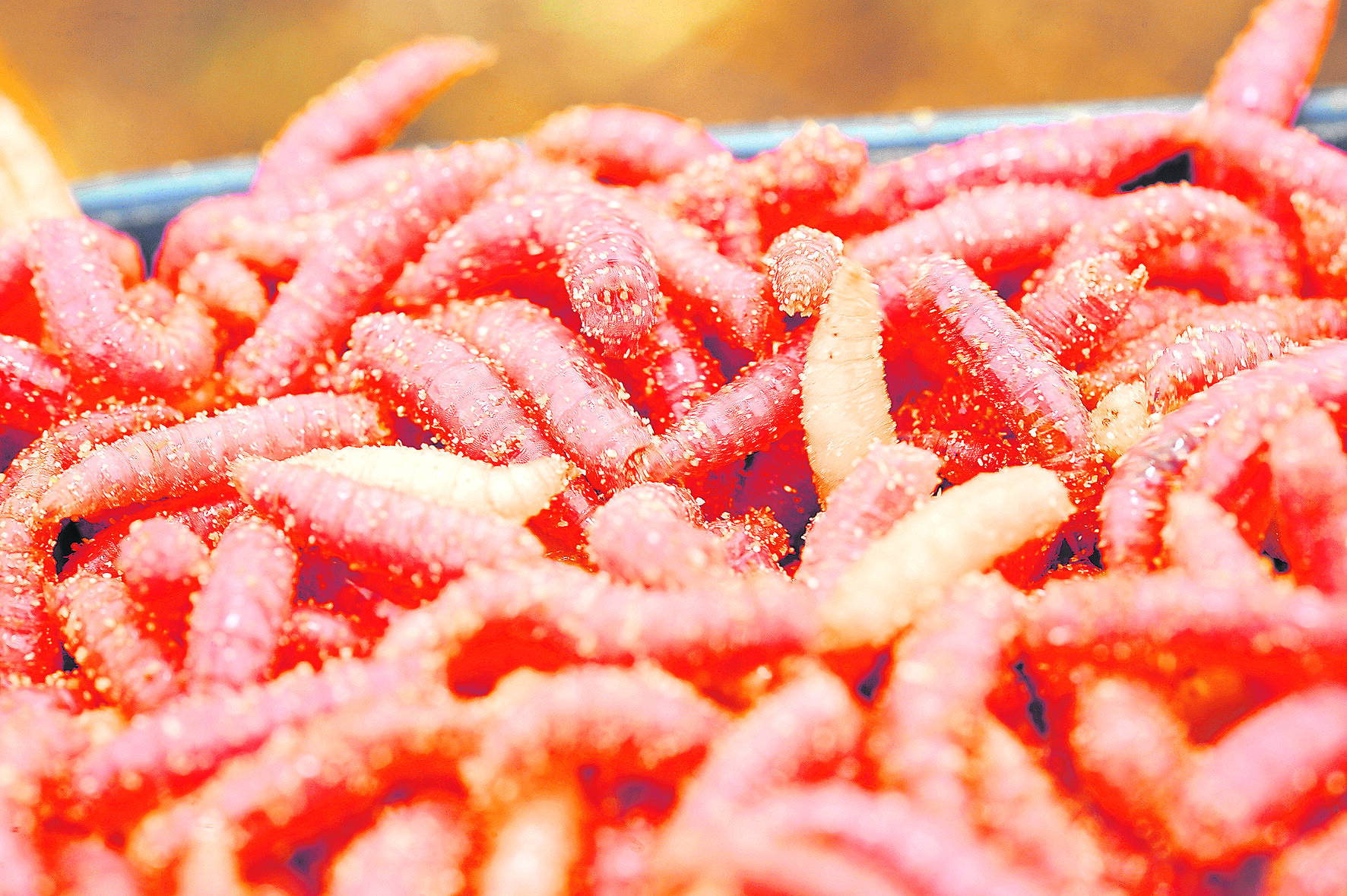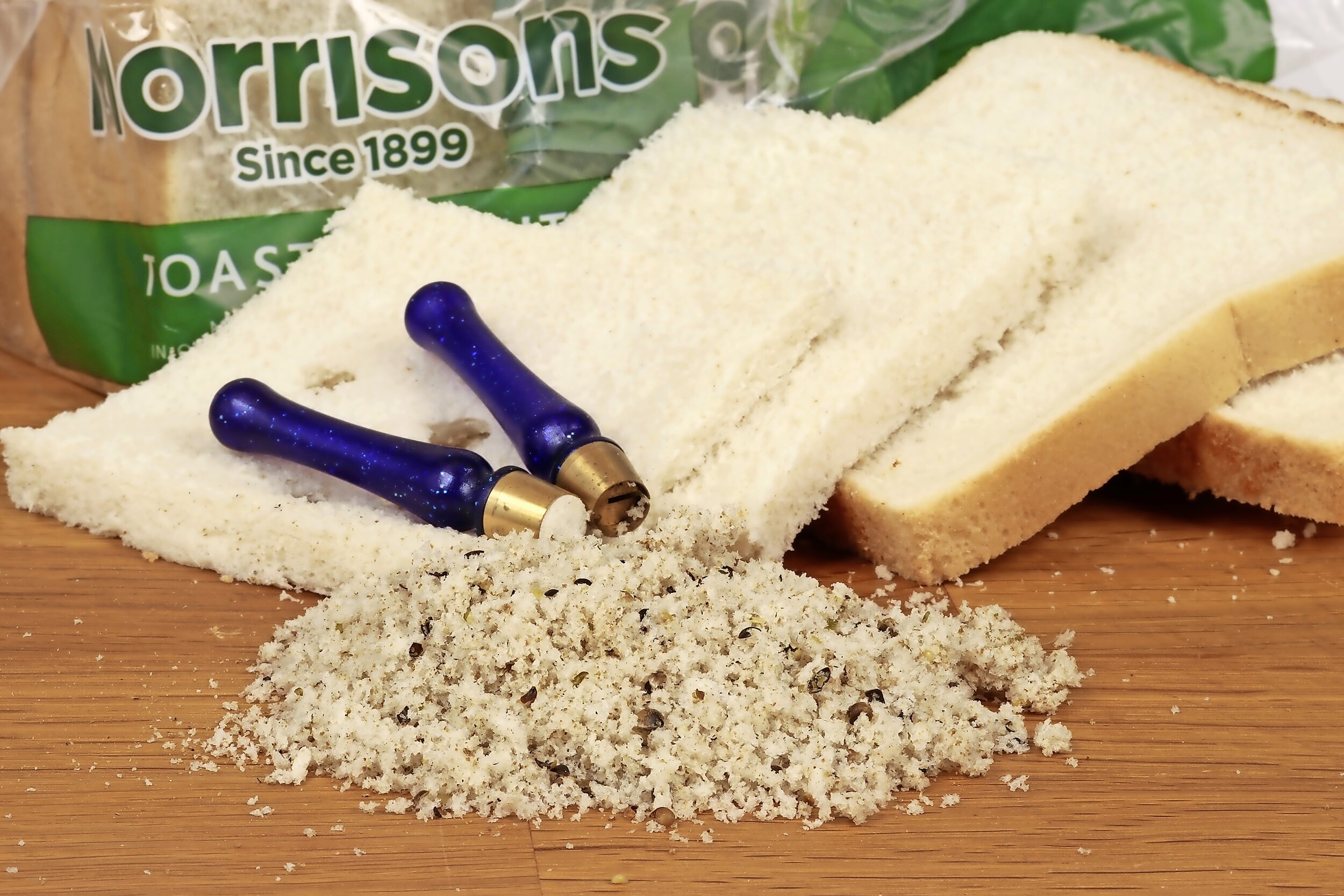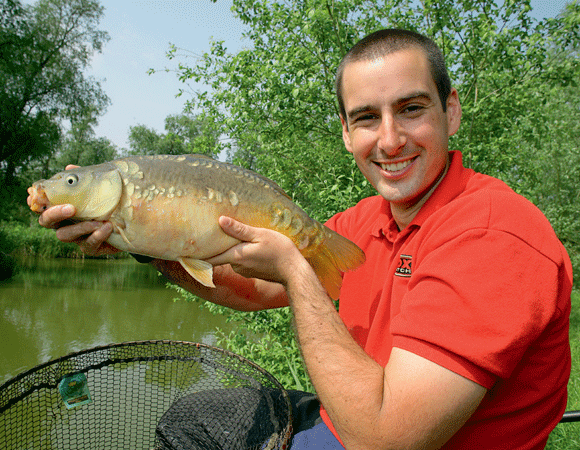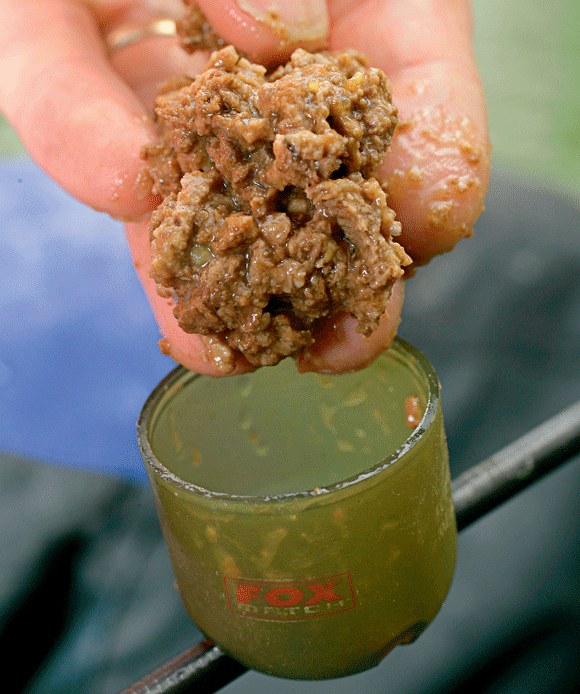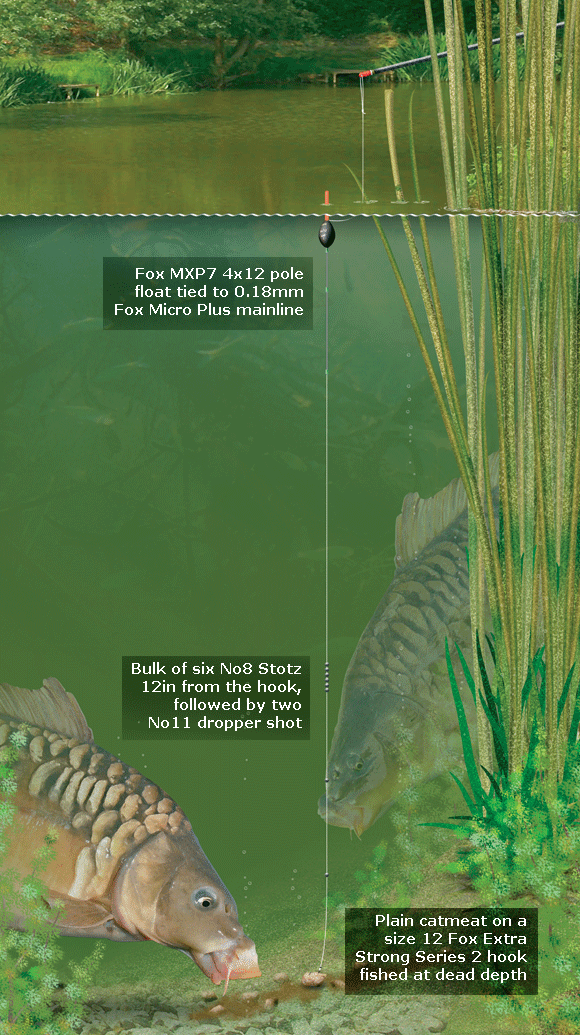Steve Ringer's top 10 baits to use when fishing commercials.
Are you looking for for an edge when it comes to being on a commercial fishery? Then follow match ace Steve Ringer's top 10 baits that he uses when fishing for carp on a commercial as these tips will give you the advantage that you need.
1) Margins – big baits means more bites
When fishing in the edge, one of the hardest things is getting a carp to pick up your hookbait, especially when a lot of them are feeding. I would go as far as to say there is nothing more frustrating than being able to see carp in the edge and then not be able to catch them. This is where a big ‘target bait’ such as 10-12 dead red maggots really comes into its own.
If you think about it there are going to be lots of maggots on the bottom so if I fish just two or three on the hook it’s going to take a while for a carp to find them. Fish a bunch, however, and bites can be instant! That’s how much of a difference it can make.
2) Blow up your pellets
A few years back I was doing a lot of straight lead and pellet fishing but always felt I was missing an edge over other anglers who were fishing the same tactic. Then one day when I was packing up I noticed a few pellets had fallen under my seatbox. What struck me was the size of the pellets – they had taken on water and were almost twice the size.
This got me thinking as the same thing had to be happening in the water once the pellets had been on the bottom a while. I therefore decided to pump some hard 8mm pellets and leave them in water so that they ‘blew up’ into massive, soft pellets.
Once I got the process of prepping the pellets rightthe results were staggering and I was getting more bites than ever before on my ‘new’ blown pellets! I had found the edge I had been looking for and ever since that day when lead and pellet fishing I always have a few ‘blown’ pellets with me.
3) Hard pellets - noise is the key
When the fishing is hard and there isn’t a lot happening I am big believer in trying to draw a few fish into the swim and the best way to do so is to make a noise with hard pellets. I pick up my catapult and ping just 3-4 pellets on top of the float every 20 seconds.
The reason this works is that carp home in on the noise of the pellets hitting the water but at the same time I’m not putting lots of bait on the bottom and risking killing the swim. Size-wise this tactic works best with either 6mm or 8mm pellets because anything smaller doesn’t make enough noise to help pull a fish or two into the swim.
4) Coloured water equals red meat
I love fishing meat but it loses its effectiveness when the water is extremely coloured. When this is the case I will take a handful of my 6mm cubes and dye them red. The reason being when the water is very coloured red offers a strong silhouette and gives the carp a bait they can really home in on.
I was always sceptical about red meat in the past but I’ve had good results using it too many times in coloured water conditions for it to be coincidence. I use Ringers Red Liquid to dye my cubes and will only dye my hookbait meat and not the cubes used for feeding.
5) Foul-hooking? Hemp is the answer
I’m often asked how to prevent foul-hooking carp when fishing meat close in?
My answer is to use hemp. But, and it’s a big but, it has to be used in the right way. If you feed it little and often along with the meat then there is a danger the carp can get preoccupied on it and you won’t be able to catch them.
It’s much better to use hemp purely as settling bait. So at the start I will pot in two thirds of a large 250ml Drennan pot of just hemp to form a bed. Then if I start to catch a few and then start to suffer from foul hooking, I will simply introduce another big pot of hemp to settle them back down again.
6) Feed heavy close in to get out of jail
Every now and again in a match you need a get- out-of-jail card and, while most people use the margins for this, I prefer to fish short on a top kit straight in front of me. I mix hemp, corn and meat and simply lash it in to create the impression of someone packing up and throwing all their bait in.
I normally kick the swim off with three big handfuls of bait and go straight in over the top because quite often I will get a quick response from a fish within seconds. From that point on I will keep lashing the bait.It’s an approach that doesn’t always work but it has paid off on many occasions for it to be my ‘go to’ line when things aren’t going to plan.
7) Pack in the particles for bream
The secret to building a big weight of bream is particles particles – casters, pellets, worms etc. I pile in the particles in the first hour to put a bed of bait on the bottom. To do thisuse a bigger feeder and cast more often. Then when the bream turn up, perhaps 90 minutes in, I have a lot more bait on the bottom to hold the bream for longer.
8) Corn – two grains are better than one
Sweetcorn is a fantastic bait all year round but it’s particularly effective at this time of year. The interesting part about corn is that when it comes to fishing it on the hook then I always tend to find that two grains are without doubt better than one.
Loads of times I have caught on corn and alternated between single and double on the hook only to find two grains constantly produced quicker bites and bigger fish. There are two possible reasons for this, firstly the bigger bait stands out more over the loose offerings so the carp spot it that bit quicker, or it could be that everyone tends to fish a single grain of corn so two grains gets treated with less suspicion.
9) Stand out or blend in?
When fishing the Method or Hybrid feeder there are loads of different hookbaits you can use but I like to simplify things by dividing them into two camps, blend-in and stand-out. Blend-in baits are those such as hard pellets that match the pellets on the feeder. When the fishing is hard this type of bait takes some beating.
The reason for this is that when the fishing is hard there aren’t many fish in the swim so those that are there can afford to be picky about what they pick up. Hence a blend-in bait works well as it can trick even the wariest of carp.
If, however, there are loads of fish in the swim then stand-out baits such as mini fluoro boilies or bread really come into their own. These work because they are highly visible and give the carp something they can really home in on.
10) Give your meat a double cut
A couple of years back I spent a lot of time at Tunnel Barn Farm fishing meat into the shallow water across to far banks and islands. The problem was I struggled to hold the fish in the swim for long periods when feeding 6mm cubes.
What I needed, of course, was to create a cloud to firstly draw the fish in and then hold them in the swim once they arrived. To achieve this I decided to create a meaty mush by passing around a third of my 6mm meat cubes back through the cutter again, giving myself a feed made up of different sizes which almost exploded on the surface of the water.
This was added to 8-10 6mm cubes in my pot so when it was fed the cloudy mush pulled the fish into the swim and once they arrived they followed the 6mm cubes down to the bottom so I could catch them!
Best coarse fishing hookbaits to be using right now!
Tommy Pickering gives his opinion on the best hookbaits that you should be using right now if you are wanting to catch consistently.
The rise in temperatures in recent weeks has stirred fish stocks into feeding, but careful consideration still needs to be given to your bait choices if you are to succeed. Pick the wrong hookbait and there’s every chance that your target species will ignore it and leave you struggling for action. If I had to pick five baits to see me through the next few weeks, these are what they would be...
Casters.
These pick out the biggest silverfish in the shoal – the orangey-brown ones are best. Double and single caster works on a size 16 or 18 hook when roach and skimmers are the target fish.
Pellets.
Fish consider these their main food source. Hard pellets in a bait band score on bomb, waggler or pole for quality carp and F1s. Soft expanders are a better option for bonus tench and skimmers.
Meat.
In winter this can be fantastic on the bomb for commercial carp and F1s or river barbel. I push a tin through a meat cutter to create 6mm or 8mm cubes. Avoid cheap, fatty brands that tend to float.
Maggots.
Maggots tend to attract small fish to start with but bigger bonus fish may then move in. Dead maggots are extremely effective when used as a hookbait on the Method feeder.
Sweetcorn.
In clear water, a grain of corn stands out a mile. Use it on the bomb on a size 16 or 18 hook when casting around to find a shoal, or loosefeed it sparingly on the pole line through a small cup.
How to use catmeat
Catmeat is one of the most effective summer commercial carp baits. Everything that we anglers dislike about catfood – the smell, the mess, greasy and oily texture – is absolutely adored by fish. Especially carp.
Add this to the fact that catmeat comes prepackaged in fantastic carp-attracting flavours like pilchard, tuna, salmon and sardine, and it’s easy to see why it is such devastating bait.
Another advantage of catmeat is its soft texture, something else that carp go for. And another plus point to this underused bait is that it’s super cheap, generally costing between 30p and 40p per tin.
To witness the power of catmeat, we joined Steve Cole, on the banks of Decoy Lakes, near Whittlesey, Cambridgeshire for a lesson in how to most effectively use it.
Steve takes a unique approach to his catmeat fishing by using it in three different ways on the same day. This allows him to target several areas with slightly different tactics from the comfort of one peg and pretty much guarantees that he’ll take rakes of fish from all areas within one five-hour session.
We set up on Decoy’s popular Willow Lake for a masterclass in catmeat fishing that you’ll find really easy to follow and copy.
Here's how Steve fishes this deadly commercial carp bait using pole tactics...
Why use catmeat?
Love it or loath it, no angler can argue about the magical fish-pulling spell catmeat seems to cast over carp. The fact that it is such an oily, slimy, rancid bait for us to handle, is its main attraction for the fish. Being meat, it is packed with protein, ideal for when carp are heavily on the feed.
Add to this all manner of different flavours – some anglers preferring the meaty varieties like heart and beef, while others place their faith in the fishy varieties – it is second to none when it comes to targeting highly-stocked commercial venue carp.
But with so many different meats on the market, it can be confusing to know which one(s) to choose.
“The cheap stuff is what I always go for,” Steve told us.
“Also, always use catmeat chunks in gravy, rather than the solid meat products.
“The great thing from an angling perspective is that the really cheap stuff is probably best. The one I use comes from the supermarket Lidl, either Coshida or Opticat which cost about 30 pence a tin.”
Unfortunately, there are a couple of drawbacks with using catmeat.
The first one is that it is a seasonal bait. Being a high protein food, it can only really be used when the carp are hard on the feed, usually between mid-May through to mid- September.
Steve revealed that he had used it in the colder months but you have to fish it on the right days and be very sparing with the amount of free offerings you put in. The second drawback is that it is banned on some commercial fisheries.
“In my opinion, catmeat has received some bad press over the years, leading to it to be banned on some fisheries where owners have deemed that it damages the fish,” Steve added.
“The trouble has been a minority of anglers piling in two dozen tins or more at a time and this has ruined it for the more sensible anglers among us. Two or three tins are more than enough for a session.
“Furthermore, I think if it is good enough to feed pampered cats, then it should be fine for carp, too.
“Also, I’m fishing today at Decoy Lakes – one of the countries premier match and pleasure complexes. The owners of this venue don’t ban catmeat and their fish stocks are healthy and the catch rates remain prolific – some of the highest in the country, in fact.”
How to prepare the catmeat slop
To prepare catmeat slop, simply push the lot through a fine mesh riddle. It can then be fed into the swim using a small Fox Toss Pot or pole cup attached to the end of the pole’s top-three section. The beauty of this is that you can be 100 per cent accurate.
The slop, once in the water, creates a lovely oily, greasy cloud of smell and attraction, but with nothing solid for the carp to feed on – apart from your hookbait.
The thing to avoid when using slop is not to use it in water that is deeper than three foot as the cloud will disperse too wide and the tactic will lose its effectiveness.
“When it comes to using the slop, always have a tub of water next to you because if you don’t wash your fingers after handling it, catmeat gets everywhere” Steve warned.
“Also, there are a number of different liquid additives on the market like Liquid Catmeat. These may make a difference, but I don’t see the point in using them – it’s gilding the lily.”
STEP ONE
Empty a whole tin of catmeat on to a fine mesh riddle.
STEP TWO
Push all the contents through the mesh of the riddle.
STEP THREE
Lots of it will stick to the bottom of the riddle, so just wipe it in to your bait tub.
STEP FOUR
The finished product is a fine, oily and meaty goo that fish adore.
Preparing the hookbait
Although there is simply nothing wrong with using the chunks of catmeat straight from the can, there's always something an angler can do to 'pep-up' the bait to make it even more appealing to carp. And also to make the bait stand out from the feed. And also to put you ahead of the angler on the next peg.
Steve utilises Dynamite Baits Green Swim Stim groundbait to give his catmeat chunks a coating that provides even more attraction.
Here's how it's done...
STEP ONE
After washing off the catmeat, by tipping it onto a riddle and rinsing, you'll be left with clean chunks of meat. Now take a bag of Dynamite Baits Green Swim Stim and sprinkle the crumb over the top.
STEP TWO
Very carefully push the chunks of meat around in the groundbait to ensure that each piece gets a good coating of the green fishmeal groundbait.
STEP THREE
The groundbait sticks to the meaty chunks to not only provide an extra scent trail, but it also forms a tougher outer layer which helps it stay on the hook at range.
SWIM ONE
Island margins
The first of Steve’s three-swim approach involved fishing up to the margins of Willow’s island.
Carp regularly patrol these features as at this time of year to be in the warmer, shallow water.
The trouble is that they go round and round, so it is up to the angler to stop them, forcing them to feed.
With most commercial islands being nine to 16 metres away, many people just fish sweetcorn or pellets because catmeat is so soft it is hard work to fish at distance. But to force patrolling carp to feed, Steve uses catmeat slop.
“Carp usually see pellet after pellet, but they’ll leap on catmeat, because it’s different. This is why it’s effective against far-off features.”
Kick off and feed
Once the slop is prepared, Steve fishes it through a Toss Pot because he’s aiming to build the swim slowly, rather than piling in a load of bait at the start.
By priming the swim with a large pole cup, you bring too many fish into the swim which will result in a lot of foul hooking, ruining the swim before you’ve even started.
With a smaller Toss Pot, Steve can feed, put his bait over the top – in this case the hookbait is a 6mm punch of plain luncheon meat – catch a fish and then repeat the process. This has the effect of slowly building the swim. The more bites he gets, the more bait goes in, the more the swim builds. If he doesn’t get a bite within four or five minutes, only then will he pot in another Toss Pot full of slop.
“You still need bait going through the water, just not too much at once, because the swim will be full of fish and it will be total chaos with fish racing all over the swim,” Steve said.
“By adding slop little and often, you keep greater control over what is happening beneath the surface.
“You can only catch one fish at a time, so why have the swim crawling with loads of carp? All you get is lots of foul hooking which then spooks the fish.”
The hookbait Steve uses on his long island line is either punches of luncheon meat or, occasionally, sweetcorn. These baits are more robust than cubes of softer catmeat so they’re easier to fish at distance, staying on the hook better.
SWIM TWO
Open water
When targeting his open water swim, Steve starts by finding the average depth of the water – generally three to eight foot on most commercial pools.
As well as fishing to the island, Steve plumbs up an area 45 degrees to the left of his island swim. This keeps his second swim away from the first.
Also, if he fishes in line with the island in his open water swim, every fish that is hooked near the island will be played through this second swim. This will spook any fish feeding in this area.
By keeping the second swim on a different line, he can get the carp feeding confidently in both areas.
When fishing in open water, Steve will feed catmeat straight out of the tin then fish ‘dusted’ catmeat over the top. Dusted meat involves washing off any gravy and sludge from the tinned meat then covering it with a sprinkling of dry groundbait.
Steve uses Dynamite Baits Green Swim Stim but any groundbait will work as long as it has a fine consistency so that it will stick to the meat.
“The groundbait creates an outer shell, toughening the meat,” Steve said.
“This process allows me to fish this soft bait at longer lengths, like today where I’m fishing at nine metres.”
The other beauty of creating a groundbait jacket is that there is a little more attraction coming off the catmeat as the groundbait breaks down.
To kick off this open area, Steve feeds a full pole cup of plain catmeat then leaves the swim to rest for an hour. After this hour he’ll fish for five minutes. If there are no carp forthcoming, he feeds the same again then leaves the swim for 30 minutes before trying again.
“The reason for leaving it an hour is so the fish in open water gain confidence,” he said.
“I’m looking for a fish straight away. If there are no bites, feed and look again in half-an-hour, just in case the fish are coming in, eating and leaving.”
SWIM THREE
The margins
Steve’s final swim of the day is in the margins. He targets this area only in the last hour of the session and doesn’t feed it at all until he is ready to fish there.
“The reason I wait till the last hour to feed and fish is that I’m trying to replicate an angler leaving for the day and throwing all their left over bait in,” Steve explained.
“The big wary fish know that later in the day these areas are safe and that they can get free food.”
To imitate a departing angler, Steve cups in three full pots of plain meat – gravy and all. He also cups it in from a height to resemble food that’s being thrown in. He will then spend the entire last hour fishing on this line when he could catch up to 50lb or more!
“I always use straight meat rather than slop in the margins as it is better for attracting larger fish,” Steve said.
“Over the top I fish a single chunk of plain meat to resemble the rest of the freebies.”
If bites dry up for 10 minutes, he’ll cup another full pot straight in.
The session
Starting the day against the island with his foul-smelling catmeat slop, Steve very quickly had his swim fizzing and bubbling as the fish drove themselves into a feeding frenzy.
A 6mm punch of luncheon meat on his hook kept bites from carp and F1s coming very steadily through the next hour.
Then it was time for Steve to look in open water. With no bites after five minutes, it was in with another pot of meat and back to the island.
After four hours, Steve was taking fish with frightening regularity from the island swim.
He’d also had a couple of large carp from open water to boost his already impressive catch. With only an hour left, it was into the margins.
Following his own advice, Steve scattered four large pots of catmeat next to a clump of reeds, before following this up with his margin rig.
Within seconds the fl oat buried and he was into a good carp, which tipped the scales to around 6lb.
By the end of his five-hour session each of Steve’s three swims had produced more than 40lb of fighting-fit carp and F1s.
He managed to keep three swims going with essentially the same bait. But by applying a little thought Steve had shown three very different uses for catmeat.
Although he used three different presentations on the day, Steve’s approach is by no means exclusive to catmeat. By thinking outside the box you too could add spice to a bait you probably thought could only be fished one way
Steve shows off his superb haul of catmeat-caught Decoy Lakes' carp
How to make your luncheon meat more attractive
Carp absolutely love luncheon meat, so fishing with cubes or torn strips of meat can prove deadly on most commercial carp waters. Tench, bream and barbel love it too.
But, most anglers know how effective luncheon meat can be, and after many months of meat being used on a venue the fish can switch off to it.
Many anglers refer to this as 'being blown' - where the bait has been so overused that the fish steer well clear of it.
That's the time when you need to try something a little different, namely flavouring the bait so that the fish view it differently and therefore will suck it up again.
Here's just one way that you can alter the flavour (and texture) of your luncheon meat, and persuade the fish into taking it again...
1. First, pour the contents of two tins of cubed up meat into a large groundbait bowl
2. Pour icing sugar on to your palm, although very sugary drinks will work just as well
3. Sprinkle the icing sugar over the cubes of luncheon meat
4. Lightly work the icing sugar into the meat, being careful not to break up the cubes
5. After a couple of minutes of mixing the oils will start to ooze out of the meat
6. Once all the meat has turned sticky and oily, pour dry groundbait over it
7. Again, the dry crumb should then be carefully worked on to the meat until all of it is covered
8. Riddle off the excess crumb. The meat can then be bagged up or used immediately
How to boost meat bait by powdering it
Sometimes the usual shop-bought luncheon meat won't produce fish like it used to, and that's probably because anglers have been using it on the same venue week in week out and have caught loads of fish on it.
The fish aren't daft - they will soon wise up to the fact that if they suck up a particular bait they will have a quick trip to a keepnet, so they begin to avoid them.
But there are certain things you can do to baits to make them appeal to the fish again, and in a way, trick them into takign the same old bait again.
One way to switch the fish back on to lunchean meat is to give it a powdered dusting that alters the bait's flavour slightly, and here's how it's done...
1. Pour off liquid and keep, as this can also be fed into the swim
2. Empty the drained meat chunks into a plastic bag
3. Liberally cover the damp meat with dry The Source groundbait
4. Lightly scrunch the bag to fully cover the meat in powder
5. Leave the coated meat 30 minutes or overnight to adhere
6. To mount, take a baiting needle and push it through the meat
7. Hook the needle on to the hook and carefully pull it through
8. Pull the hook all the way through the meat chunk
9. To finish, turn the hook 90 degrees and press into the cube
Everything you need to know about luncheon meat
What is it?
The bane of schoolboy’s sandwiches, luncheon meat is actually one of the most versatile baits the angler has, working for everything from carp on commercial fisheries to hard-fighting river barbell and chub and even 60lb plus catfish!
Soft in texture and packed with oils, meat is especially deadly in spring, summer and autumn although it can still work in winter when fished as a single bait with no feed.
On the river front it has lost ground in recent years to paste, pellets and boilies for specimen fish but on days when all else fails, a tin of meat can often winkle out a fish or two – big fish man Ray Walton has an enviable list of barbel bests all taken on his rolled luncheon meat method on rivers like the Stour, Avon and Ouse.
Where do I buy it from?
Plain luncheon meat is available on almost every supermarket shelves with popular brands including Princes and Plumrose, which has attained almost cult status amongst match anglers.
Some bait companies also sell meat specially designed for fishing, in a range of colours and flavours – check out the likes of Sensas, Dynamite Baits and Van Den Eynde.
How do you fish it?
Meat can be fished on almost any method you wish but being quite soft it doesn’t stand up that well to long range casting. Fishing it on a hair-rig can help here but generally, it’s a bait best suited to short casts, margin work or polefishing.
Can it be flavoured?
Yes it can! Changing the flavour of meat can make a drastic change to your catch rate, lowering the guard of the fish and working well with other feeds such as pellets, hemp and sweetcorn. Popular flavours include Scopex, Strawberry, Mussel and spices such as cinnamon, paprika and curry powder.
To flavour meat, follow this simple guide:
1 The evening before fishing, cut the meat into the size you need. Small cubes are ideal for carp and tench while larger chunks work best for bigger fish such as barbel.
2 Pop the meat into a plastic bag and add your flavouring. Be careful not to overdo the amounts as most additives are pretty powerful!
3 Blow air into the bag to inflate it and tie it off. Now give the bag a good shake to disperse the flavourings, evenly coating the meat.
4 Pop the bag into the fridge overnight and by morning the meat will have absorbed the flavouring and is ready to use.
What about colouring?
On some waters, dyed meat works to the exclusivity of every other bait with red especially deadly. Meat will absorb colours fully over time and plain old food colouring will work but far better are the myriad of specially-designed fishing colours from manufacturers like Nash, Richworth and Mainline. You can colour luncheon meat while flavouring it, simply adding a good glug to cubed meat and leaving overnight.
What sized piece should I fish?
Experimentation is key here, but generally speaking small quarter inch cubes or meat punched with specially-designed punches will do well for commercial carp, tench and bream. On rivers where chub and barbel are the targets, try ripping larger irregular-shaped pieces off the block of meat by hand. The non-uniformity of these pieces will often fool a fish that has seen it all before.
Punched meat can work especially well on venues where hook pellets are banned, especially when fishing shallow. By punching meat and leaving it to toughen in the sun, you create hard, pellet-shaped baits that will stay on the hook nicely.

